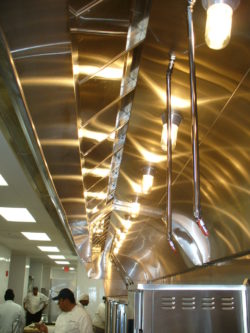 For years, culinary industry professionals have looked at commercial kitchen ventilation as a necessary evil. Basically, there had to be an exhaust hood and it had to suck out a lot of air. The more the better was the trend, which created work environments that were thankfully free of smoke and most of the kitchen heat. Of course, in the process of solving those issues, new ones were created.
For years, culinary industry professionals have looked at commercial kitchen ventilation as a necessary evil. Basically, there had to be an exhaust hood and it had to suck out a lot of air. The more the better was the trend, which created work environments that were thankfully free of smoke and most of the kitchen heat. Of course, in the process of solving those issues, new ones were created.
All of those exhaust hoods were terribly loud, and they were pulling large amounts of perfectly good conditioned air from the space and rushing it to the parking lot! So unfortunately, in many cases, poor air balance and the expensive waste of quality air were the results of high-volume ventilation. In today’s world of energy-saving and green design, this was an area of commercial kitchen design that needed to be addressed.
Earlier attempts by national commercial exhaust hood manufacturers to alleviate the problem were somewhat successful in reducing the actual amount of air required to exhaust the kitchen equipment. This was accomplished by sizing the CFM requirements based on the equipment beneath the hood. However, it wasn’t until fairly recently that real measures were taken to lower air requirements through commercial kitchen hood design and control.
We are now in an age where companies can truly reduce the amount of air required to be exhausted and save energy that was previously wasted. One of them, Avtec, designs and manufactures a variety of ventilation hoods that can reduce the amount of exhaust air required by 30, 40 or even 50 percent depending on the specific equipment under the hood. This results in significant savings not only by minimizing the amount of expensive conditioned air (heated or cooled) exhausted from the kitchen, but also by allowing the initial kitchen design to use smaller HVAC units, since they do not have to be designed to replace as much exhausted air.
Recently, these advancements have been further enhanced by the arrival of several innovative hood control systems that actually raise and lower the fan speed and capacity based on when or how much cooking is being conducted. This capability minimizes air removal when the hood is on, but no food is being cooked, and also allows for a truly energy-saving piece of equipment, since the hood only operates at its highest draw when needed.
Don’t take commercial kitchen ventilation for granted. There are many ways to save money and energy by taming this formerly energy-gobbling beast. Feel free to email me directly with any questions, or visit our Avtec ventilation section for more information.
Eric Von Kaenel
Avtec Product Specialist
evonkaenel@unifiedbrands.net